Railroad Maintenance-Of-Way Equipment
Last revised: March 2, 2025
By: Adam Burns
Railroad maintenance-of-way has long been an important part of railroading although not always mechanized like it is today.
During the 19th century the work was performed entirely with manual labor. Large section gangs could be found all along the main line keeping it serviceable on a daily basis.
Naturally, the task was both backbreaking and dangerous. It was not until the early 1900's that the first forms of mechanization appeared. One of the most popular was the do-it-all Jordan Spreader.
This easy-to-maintain and relatively simple machine could perform a wide variety of tasks ranging from ballast regulation to snow removal.
They were used throughout the 20th century and can still be found on some railroads today. As time passed, and technologies improved, newer designs with specialization in mind eventually replaced the Jordan.
Take, for instance, the ditch cleaner, which effectively returns ditches to maximum efficiency. Another is the undercuttter, a beastly contraption capable of removing ballast from beneath the track all by itself.
There is also equipment to quickly and efficiently insert ties, plates, and spikes. These machines, and others, have largely removed the human element. However, the age-old task of doing this by hand still endures today.
Photos
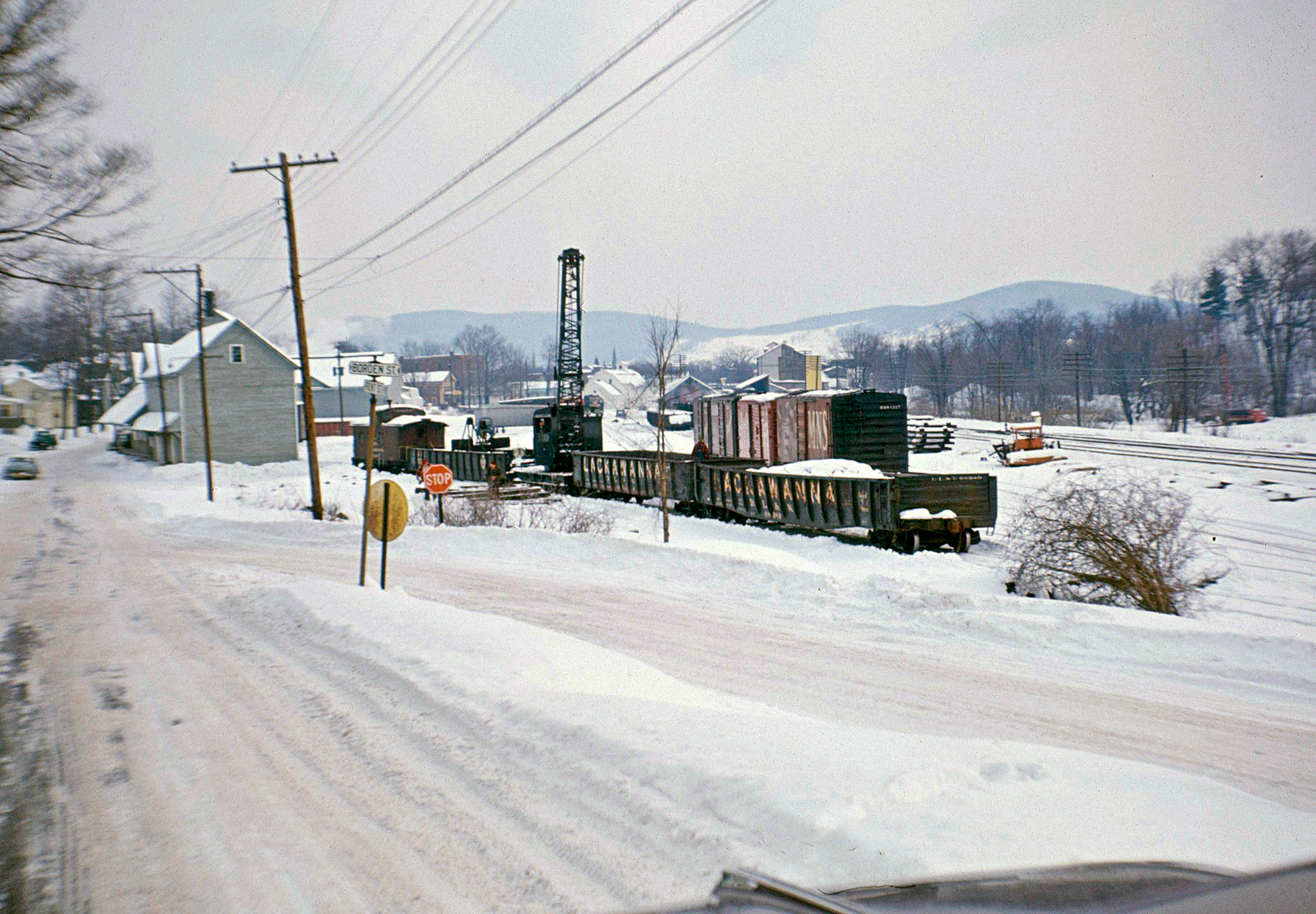 An Erie Lackawanna maintenance-of-way crane is seen here at work at the railroad's small yard in Deposit, New York during the early 1960s. The former Erie main line can be seen at right. American-Rails.com collection.
An Erie Lackawanna maintenance-of-way crane is seen here at work at the railroad's small yard in Deposit, New York during the early 1960s. The former Erie main line can be seen at right. American-Rails.com collection.Overview
The most important aspect behind any rail maintenance-of-way program is keeping the track and right-of-way in working order.
During the industry's early days a wide variety of gauges were utilized ranging from two to six feet. Eventually, the industry settled on the "Stephenson Gauge" (standard gauge) of 4 feet, 8 1/2 inches.
History
The use of such an odd width can be traced back to England, birthplace of the railroad. In his book, "The American Freight Train," author Jim Boyd notes the country's early carriers, the Stockton & Darlington and Liverpool & Manchester, used this gauge.
It was based from the width of ancient Roman chariot roads found there. The practice carried over to the United States and, like England, eventually adopted as its standard.
Before the railroad proved its worth as a fast and efficient mode of transportation a number of technological improvements were needed.
The first was the steam locomotive. The book, "Railroads In The Days Of Steam" from the editors of American Heritage, points out American inventor Oliver Evans recognized the steam engine's capabilities.
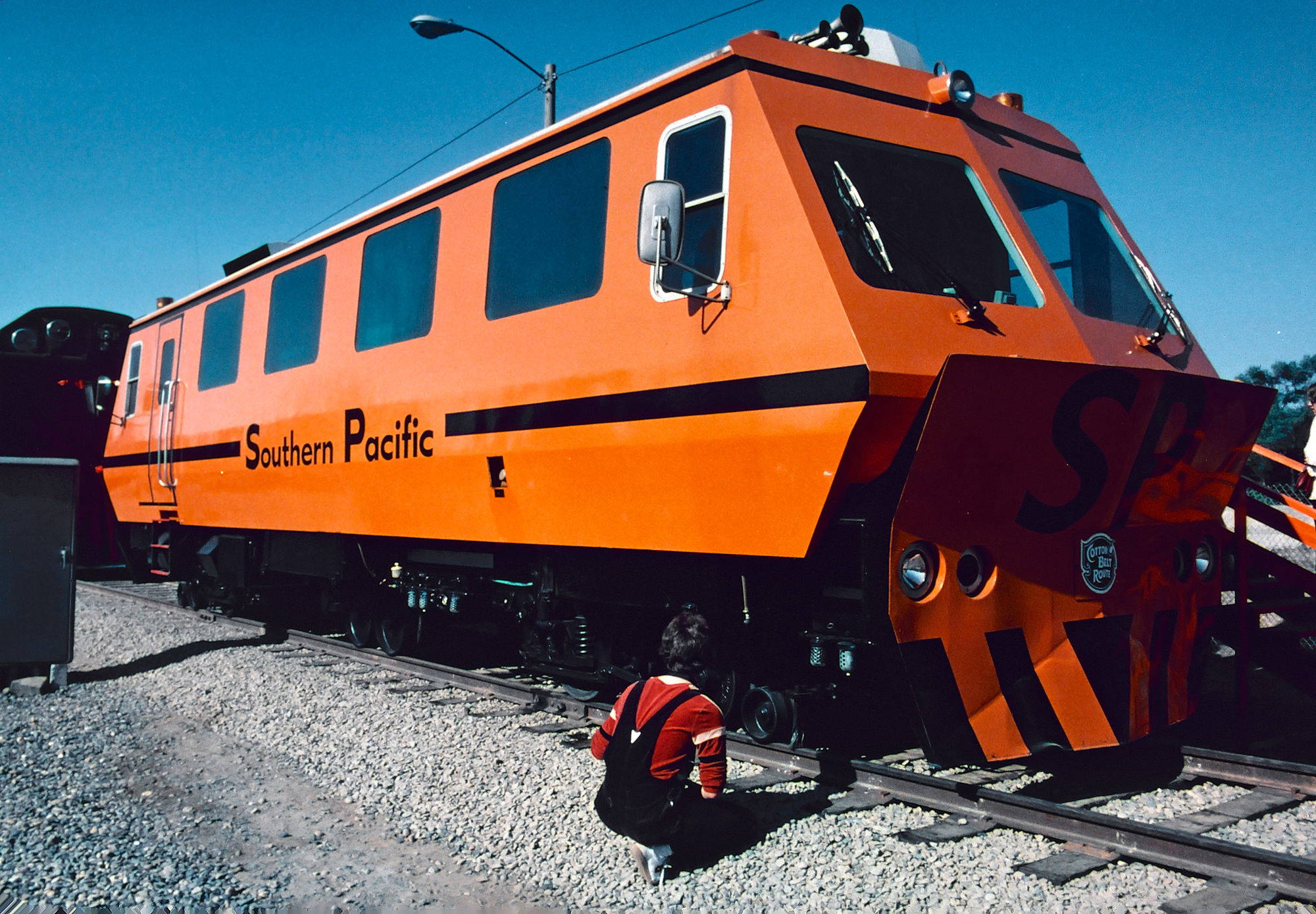 Southern Pacific track geometry car GC-1 (manufactured by Plasser-American),, on display at Railfair '81 in Sacramento during May of 1981. William Myers photo. American-Rails.com collection.
Southern Pacific track geometry car GC-1 (manufactured by Plasser-American),, on display at Railfair '81 in Sacramento during May of 1981. William Myers photo. American-Rails.com collection.As early as 1813 he attempted to build a steam-powered carriage system connecting New York and Philadelphia. It was to run on a wooden track structure and operate at speeds up to 15 mph. Unfortunately, he died before having the chance to test his theory.
Nevertheless he is quoted as saying, "I do verily believe that carriages propelled by steam will come into general use, and travel at the rate of 300 miles a day." His words proved incredibly accurate!
Colonel John Stevens went on to charter the first railroad in North America, the New Jersey Railroad Company in 1815, although it was not actually built until 1832.
He also tested the first type of steam locomotive in 1826, showcasing his "Steam Waggon" at his estate in Hoboken, New Jersey along a short stretch of track. Several other advancements propelled the industry forward in both safety and speed such as the knuckle-coupler, air brake, iron "T"-rail, introduction of steel, and high capacity boilers.
Rail equipment is inherently heavy and as weights increased improvements were needed. This led to the development of steel rails, sufficient ballasting, stronger bridges, and dense cross-ties made of hardwoods.
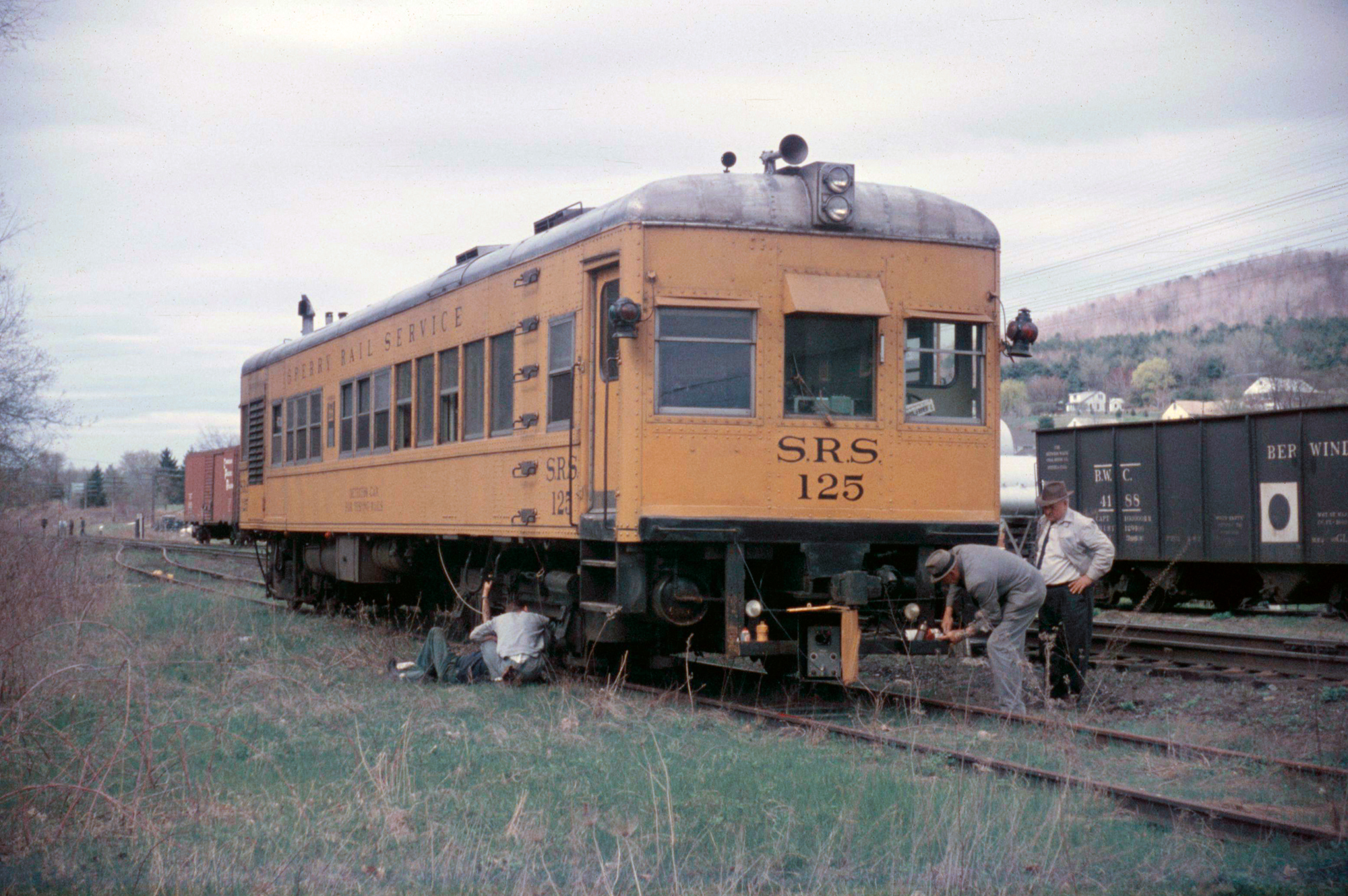 Sperry Rail Service car #125 receives attention along the Erie Lackawanna in May, 1964. Location not listed.
Author's collection.
Sperry Rail Service car #125 receives attention along the Erie Lackawanna in May, 1964. Location not listed.
Author's collection.The ballasting and ties are just as important as the actual rails. According to Brian Solomon's book, "Railway Maintenance: The Men And Machines That Keep The Railroads Running," ballast performs three primary functions; it acts as a stabilizer in keeping rails and ties firmly in place, distributes the weight evenly throughout the ties, and carries water away from the track structure.
The latter purpose is perhaps the most important. Not only will rails rust and ties rot when exposed to water for long periods but its presence will eventually undermine the entire right-of-way.
Properly maintained trackage features ballast several inches above the roadbed, profiled at an angle towards ditches which carry away the water.
A well-manicured line is also free of grime, dirt, or other substances which could foul the ballast and prevent it from efficiently doing its job. Crushed stone works best since it acts as a sieve while providing a good support base.
Like anything left in the weather ballast will acquire significant debris after years of exposure. A machine known as a ballast cleaner carries a singular job of cleaning these stones, extending its life without the need of constant replacement.
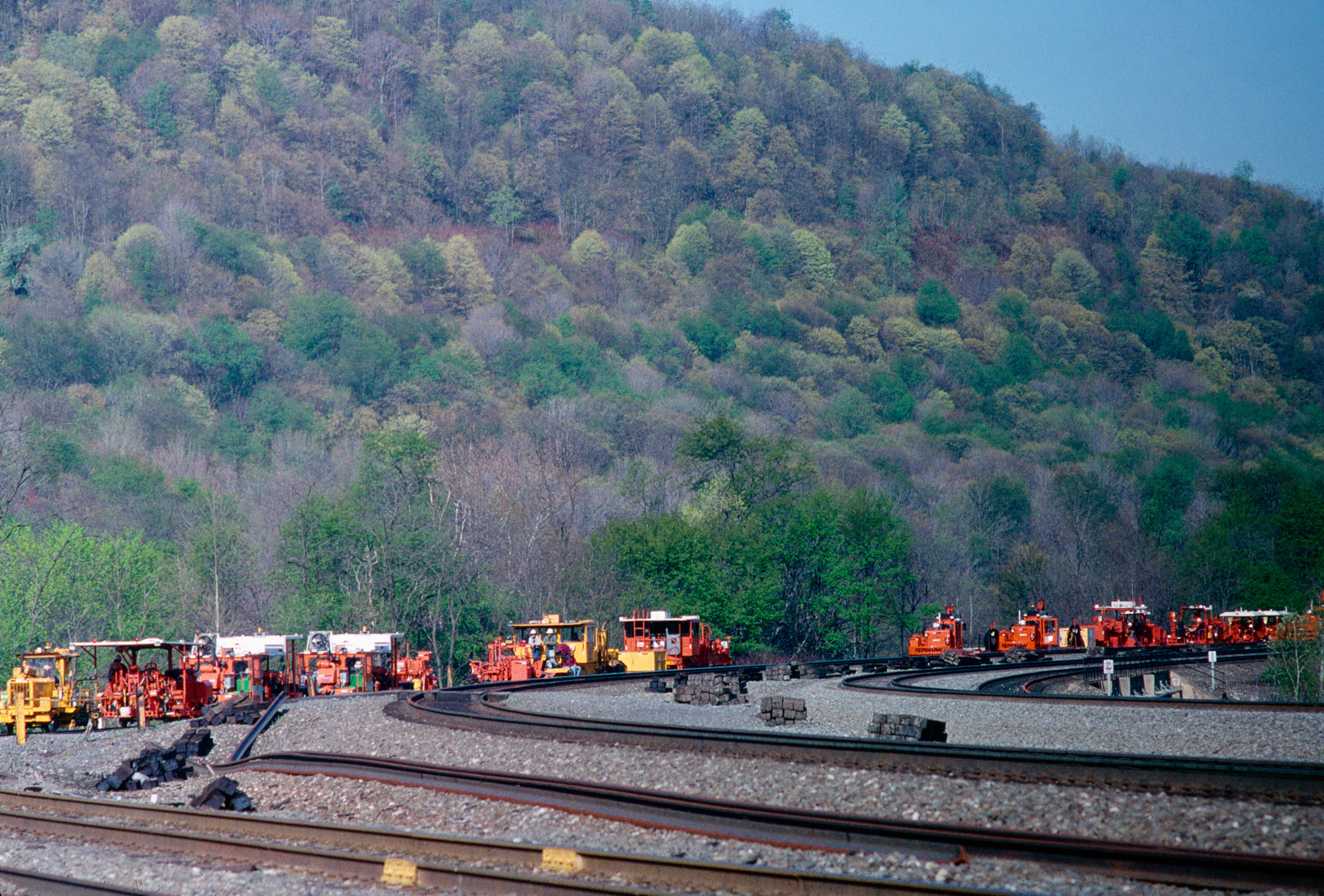 A Norfolk Southern track gang carries out a maintenance blitz along the former Pennsylvania Railroad main line at South Fork, Pennsylvania in April of 2000. American-Rails.com collection.
A Norfolk Southern track gang carries out a maintenance blitz along the former Pennsylvania Railroad main line at South Fork, Pennsylvania in April of 2000. American-Rails.com collection.Before the invention of mechanized equipment the entire process was done by hand. Crews would shovel out the stone (a tedious process that also meant digging out the rocks between the ties), then use a large screen to remove particulates. Depending on the route not every line featured liberal use of expensive crushed stone.
On lightly used branches or secondary corridors sometimes spent coal (cinders) was substituted or in other cases very little, if any, ballasting could be found!
The most common type of cleaner is the shoulder ballast cleaner, which scopes up rock to each side of the track, cleans it onsite and then returns it to the right-of-way. However, as Mr. Solomon notes these machines only clean up to 40% of the ballast.
The remainder beneath the rails cannot be reached requiring a more powerful device known as an undercutter. It will pick up the entire track, dig out the stone, and place everything in waiting trucks or hoppers to be carried away.
They tend to be used only when needed since the stone cannot be immediately cleaned and redeposited along the right-of-way.
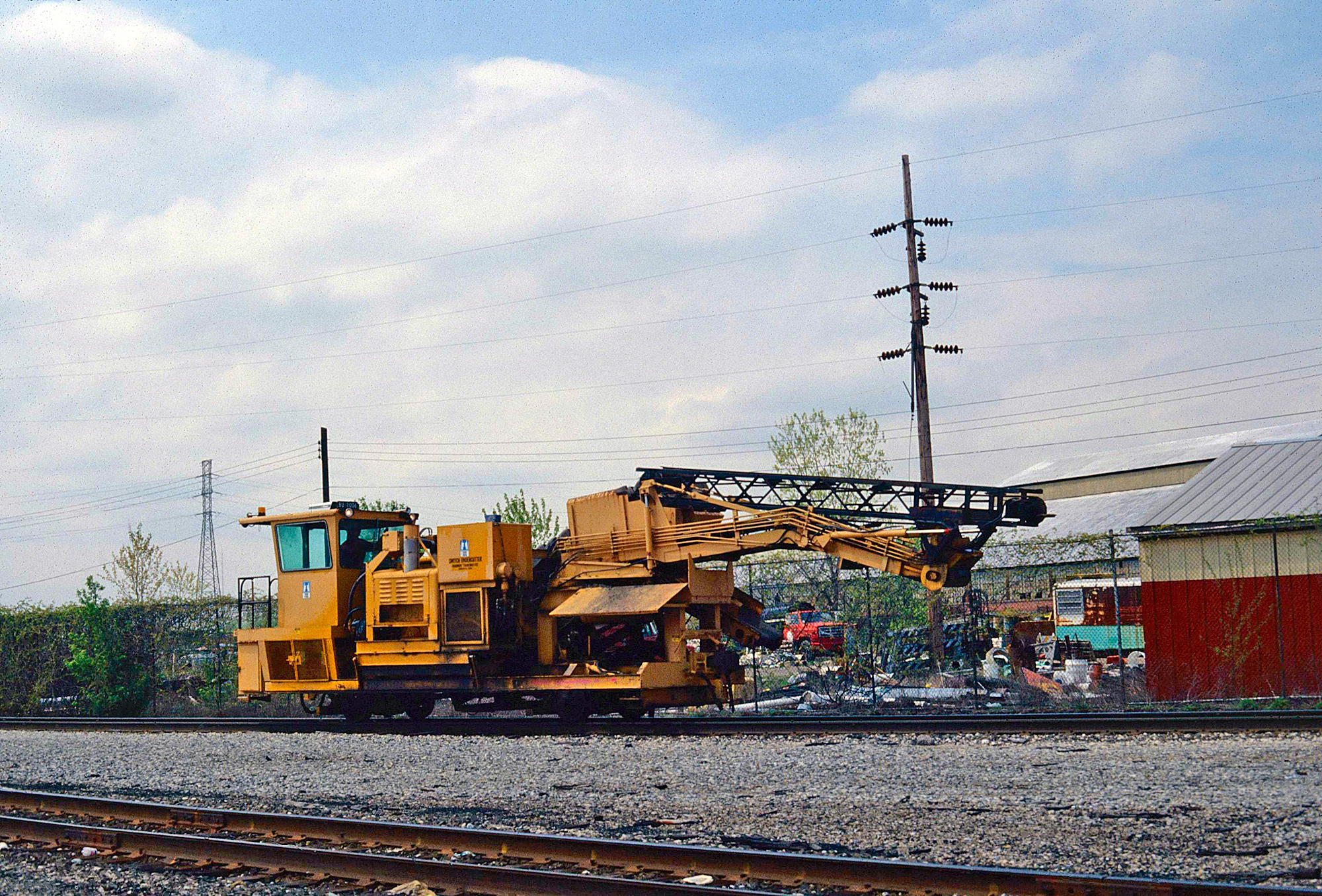 A Conrail switch undercutter at Air Line Junction in Toledo, Ohio; May, 1994. As its name suggests, this particular machine pulls up switches, and subsequently removes and cleans the ballast. American-Rails.com collection.
A Conrail switch undercutter at Air Line Junction in Toledo, Ohio; May, 1994. As its name suggests, this particular machine pulls up switches, and subsequently removes and cleans the ballast. American-Rails.com collection.For years railroads used an army of employees, known as section hands, to keep a particular block of main line serviceable. Their responsibilities included everything from replacing worn ties and potentially broken rails to cleaning ditches.
Today, the largest, newest and most impressive types of equipment will almost always be found on the large Class I's (BNSF Railway, Canadian National, Canadian Pacific, CSX Transportation, Kansas City Southern, Norfolk Southern, and Union Pacific).
Smaller railroads also occasionally boast their own arsenal of machines but usually contract out this work to companies like R.J. Corman, which began as a single-man operation in 1973 headed by Rick Corman.
He provided maintenance, via a solitary backhoe, for any railroad which would hire him.
Mr. Corman eventually built his empire into a massive operation that today includes short lines, dinner trains, equipment rentals, signal systems, and of course MOW services operating in 24 states. For more reading about the types of maintenance equipment please visit the links above.
Types
Shoulder Cleaners
Ditch Cleaners
Jordan Spreaders
Defect Detection Cars
Undercutters
Ballast Regulators
Spike Inserters/Pullers
Tampers
Tie Cranes
Tie Extractors/Inserters
Other Vehicles
Rail Grinders
Snow Plows
Speeders/Motor Cars
Beyond physical tasks is the complex maintenance of the rail. Known as ultrasonic and induction testing companies such as Sperry Rail Service are contracted to find the tiniest of cracks within the rail to prevent potential disasters and derailments.
Defect detection cars have greatly advanced in their ability to find these problems although their use can be traced back to the early 20th century.
If such issues are not constantly monitored an accident is only a matter of time. When a crack forms the rail will eventually give out and a derailment will occur.
As railroads progress into the future infrastructure components of today will almost certainly become obsolete like the tell-tale, roundhouse, and interlocking tower.
But, important components like the rails, ties, and ballasting most likely will not change much over the next century just as they haven't during the past 100 years.
Recent Articles
-
Kentucky Scenic Train Rides At KRM!
Jan 09, 26 11:13 PM
Located in the small town of New Haven the Kentucky Railway Museum offers a combination of historic equipment and popular excursions. -
Washington "Wine Tasting" Train Rides
Jan 09, 26 08:53 PM
Here’s a detailed look at where and how to ride, what to expect, and practical tips to make the most of wine tasting by rail in Washington. -
Kentucky's - Wine Tasting - Train Rides
Jan 09, 26 08:21 PM
Kentucky, often celebrated for its rolling pastures, thoroughbred horses, and bourbon legacy, has been cultivating another gem in its storied landscapes; enjoying wine by rail. -
Kentucky's - Murder Mystery - Dinner Train Rides
Jan 09, 26 01:12 PM
In the realm of unique travel experiences, Kentucky offers an enchanting twist that entices both locals and tourists alike: murder mystery dinner train rides. -
Utah's - Murder Mystery - Dinner Train Rides
Jan 09, 26 01:05 PM
This article highlights the murder mystery dinner trains currently avaliable in the state of Utah! -
North Carolina Dinner Train Rides At NCTM!
Jan 09, 26 12:51 PM
Tucked into the Piedmont town of Spencer, the North Carolina Transportation Museum is the kind of place that feels less like a typical museum and more like a living rail yard that never quite stopped… -
Tennessee Dinner Train Rides At The TVRM!
Jan 09, 26 12:39 PM
Tucked into East Chattanooga, the Tennessee Valley Railroad Museum (TVRM) is less a “museum you walk through” and more a railroad you step aboard. -
New York Scenic Train Rides On The A&A!
Jan 09, 26 11:20 AM
The A&A is both a common-carrier short line moving freight and a heritage railroad hosting popular excursion trains, all on the same storied right-of-way. -
Pennsylvania Scenic Train Rides In Hollidaysburg!
Jan 09, 26 11:14 AM
Tucked into the Juniata River valley just south of Altoona, the Everett Railroad offers one of the most approachable—and photogenic—heritage-rail experiences in Pennsylvania -
Montana Dinner Train Rides Near Lewistown!
Jan 08, 26 03:03 PM
The Charlie Russell Chew Choo turns an ordinary rail trip into an evening event: scenery, storytelling, live entertainment, and a hearty dinner served as the train rumbles across trestles and into a t… -
Alabama's - Murder Mystery - Dinner Train Rides
Jan 08, 26 02:19 PM
There is currently one location in the state offering a murder mystery dinner experience, the Wales West Light Railway! -
Rhode Island's - Murder Mystery - Dinner Train Rides
Jan 08, 26 01:43 PM
Let's dive into the enigmatic world of murder mystery dinner train rides in Rhode Island, where each journey promises excitement, laughter, and a challenge for your inner detective. -
Florida's - Wine Tasting - Train Rides
Jan 08, 26 01:13 PM
Wine by train not only showcases the beauty of Florida's lesser-known regions but also celebrate the growing importance of local wineries and vineyards. -
Texas's - Wine Tasting - Train Rides
Jan 08, 26 12:30 PM
This article invites you on a metaphorical journey through some of these unique wine tasting train experiences in Texas. -
New York's - Wine Tasting - Train Rides
Jan 08, 26 11:32 AM
This article will delve into the history, offerings, and appeal of wine tasting trains in New York, guiding you through a unique experience that combines the romance of the rails with the sophisticati… -
California Dinner Train Rides In Sacramento!
Jan 08, 26 11:21 AM
Just minutes from downtown Sacramento, the River Fox Train has carved out a niche that’s equal parts scenic railroad, social outing, and “pick-your-own-adventure” evening on the rails. -
New Jersey Dinner Train Rides In Woodstown!
Jan 08, 26 10:31 AM
For visitors who love experiences (not just attractions), Woodstown Central’s dinner-and-dining style trains have become a signature offering—especially for couples’ nights out, small friend groups, a… -
Nevada's - Murder Mystery - Dinner Train Rides
Jan 07, 26 02:12 PM
Seamlessly blending the romance of train travel with the allure of a theatrical whodunit, these excursions promise suspense, delight, and an unforgettable journey through Nevada’s heart. -
West Virginia's - Murder Mystery - Dinner Train Rides
Jan 07, 26 02:08 PM
For those looking to combine the allure of a train ride with an engaging whodunit, the murder mystery dinner trains offer a uniquely thrilling experience. -
Kansas's - Murder Mystery - Dinner Train Rides
Jan 07, 26 01:53 PM
Kansas, known for its sprawling wheat fields and rich history, hides a unique gem that promises both intrigue and culinary delight—murder mystery dinner trains.

















